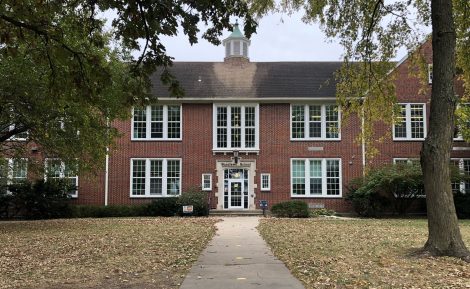School’s solar panels will empower student learning

Patrick Gerring of Cromwell Environmental wires in a set of six solar panels on the roof of Southwest Junior High School, 2511 Inverness Drive. The panels are being installed as part of a nationwide project, Solar 4 R Schools, that aims to raise awareness of renewable energy.
The sun is giving a boost to Southwest Junior High School.
A crew on Monday finished installing a 1.2-kilowatt solar module on the roof of the main entrance to the school, 2511 Inverness Drive.
Solar power will provide a portion of Southwest’s energy needs, but school leaders say the educational component will be the greatest benefit.
“The important thing is that our students and the community will see that an installation of this nature looks good,” said Southwest Principal Trish Bransky. “We’ll be generating data 24-7, and we’ll be able to see how much energy we are offsetting.”
The project was mostly financed by the the Bonneville Environmental Foundation, based in Portland, Ore., which develops and manages Solar 4 R Schools. The Bonneville foundation allows area businesses to purchase renewable energy credits, known as “green tags” through Zephyr Energy, and proceeds from those sales will fund the solar project at Southwest.
No taxpayer funds were used on the project, as Lawrence resident Sarah Hill-Nelson and school leaders also applied for a $7,000 grant from the Douglas County Community Foundation’s Elizabeth Schultz Environmental Fund to cover half of the installation costs.
Jordan House, director of sustainable energy for Cromwell Environmental, started installing the solar module Friday. Typically, a 4-kilowatt solar module system is put on the roof of a house, and that helps offset a home’s summer electric costs, House said.
But the Bonneville foundation wanted to install smaller solar module systems so the projects could involve more schools and students, he said.
“The teaching that goes with that, that’s the real value that comes with this,” House said.
About 20 schools across the country have similar solar modules, according to the Web site, www.solar4rschools.org, which provides data and allows visitors to compare the sites. A kiosk will be installed in a couple weeks at Southwest.
House said technological advancements had made solar power systems “no longer an exotic, high-maintenance technology.”
The Bonneville foundation also provides a curriculum. Southwest physical science teachers Dwight Lassen and Jim Frink will take the lead in using the data in their classes, but other teachers and students will be involved, Bransky said.
Hill-Nelson said she hoped Southwest could be a pilot project for the area.
“This is really an opportunity for students to think about their energy and how it’s getting to them and how they are using it,” said Hill-Nelson, of Zephyr Energy and a representative of the Bonneville foundation.







